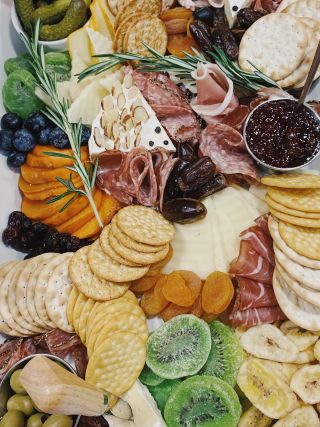Trauma
Toward a Social Psychology of Charcuterie Boards
What lies beneath the surface with the popularity explosion of these boards?
Posted March 27, 2023 Reviewed by Michelle Quirk
Key points
- Charcuterie boards can be festive and fun while also revealing other issues and dynamics in the culture.
- An examination of charcuterie boards invites us to consider issues of excess, problems with binge eating, and what we truly are craving.
- An exploration of charcuterie boards helps us see these as a gendered phenomenon.
A number of years ago at the university, I created a brand-new course offering titled the Sociology of Food, which continues to fill every semester. It’s an eight-week accelerated class that a student referred to as having “lots of to-go plates” because there’s so much to think about.
A sociology of food is at once private, personal, familial, relational, interactional, public, environmental, national, and global. It stands at the intersections of the family, the body, and emotions, and it widens out to considerations of health, the environment, and human rights.
In my book titled Welcome to Wherever We Are: A Memoir of Family, Caregiving, and Redemption (Rutgers 2020), I wrote a meditative piece about food and the role of the dinner table in our lives in which I said, “The daily acts of shopping for food, preparing meals, cooking, sitting down to eat, cleaning up, or dining out can be intimate or distancing, forging both connection and disconnection” (p.83).
On the surface, food is nourishment; it is what we each need to survive. If there's one truism in my discipline of sociology, it's that things aren't always as they seem, and there's much lurking beneath the surface.

I even see this with the charcuterie board craze.
A year ago, a friend invited me to join a Facebook group about charcuterie boards. There are close to 100,000 people in this group, seemingly all women. So, in the midst of all the other things that show up on my newsfeed, there are pictures of the latest posts from that group. Charcuterie boards are all the rage. They date back to 15th-century France and became popular in the United States in the '90s.
Over the past several years, their popularity skyrocketed. It has become a form of arts and crafts, and a way for people to snack and socialize at home, and we see boards featured on more restaurant menus as well. I’ve been struck by the popularity of this trend coinciding with the pandemic given the ways that the boards can prompt using one's fingers to grab food and also double dipping.
You can Google almost anything and discover that there's a charcuterie board for it. Not only are there the traditional ones with salty meats and cheeses, but there are also cookie boards, brunch boards, potato boards, butter boards, and popcorn boards. Name a food, and there's likely a board for it.
These boards are a party unto themselves, a dazzling display of an array of foods that sometimes go together and sometimes really don’t. Showcasing all sorts of different tastes, smells, textures, colors, and crunch, some boards look no more complicated than a Bento box, with compartments of food, often delivered for parties and gifts. Some aren’t even boards at all. Rather, they are full-length tables of food, meticulously arranged, and also spilling all over, looking bountiful. Without a doubt, many boards look festive and colorful, and some people are unusually creative, making patterns and depictions of animals or words or other things.
I grew up with a mother, father, and grandmother who all delighted in the most exquisite displays of food on gorgeous ceramic and glass platters collected on trips. I truly value the beauty of presentation and the way food can be not only yummy tasting but also yummy looking, reawakening our senses in a multidimensional way. I certainly see these boards as artistic, yet like with so many things swirling about in the culture, it's worth looking deeper to see what else is going on.
The boards are about abundance, yet simultaneously display excess. Often, foods that you can’t imagine eating at the same time are juxtaposed for the sake of creating a visually appealing board. And there’s so much of everything. One look at the boards, and you realize the time involved in hunting down and gathering all the provisions at a variety of stores and through Web sites, curating the most attractive containers to place on the boards to serve things like dips and fondues, and arranging everything in a way that looks inviting and effortless.
The boards reveal a normalization of bingeing. There’s so much food in every direction, so much that doesn’t make sense together, and yet more and more is heaped on. Most boards showcased on social media are at once savory, crunchy, creamy, salty, and sweet.
Presentation is everything. As the boards don’t require prior skills to make, anyone can design them and anything can be thrown together and arranged in a fancy way. One could cook and bake from scratch, though it appears to be more common to gather provisions from many different shops and specialty markets and to spend time arranging. We are a nation fixated on self-presentation, and it's no wonder that it even extends here. Charcuterie boards are about how it all looks; it’s like a spa makeover for your plates where even salami can be transformed into roses.
An exploration of charcuterie boards helps us see these as a gendered phenomenon. Women have designed businesses related to preparing charcuterie boards, scrambling around in a frenzy to find good deals on dark chocolates, shortbread cookies, grapes, nuts, dried fruit, unusual crackers, the best fig jam, whole-grain mustards, red pepper jellies, and artisan cheeses, yet at price points that are still approachable for their customers. Many people could make a decent board themselves, but, in an age of takeout food, prepared foods, and the drive-thru, buying ready-made boards is common for parties and gifts.
There’s something paradoxical happening with so many people, namely women, obsessed over making, serving, and selling charcuterie boards. Women are socialized to manage restriction for themselves at the same time that they are socialized to manage indulgence, especially when it relates to entertaining others. In fact, this is something we regularly see, yet the absurdity barely registers, on the cover of many women’s magazines that feature recipes for decadent desserts alongside extreme, fad diets.
We have a deeper hunger. As I write in my book, “Loaded on our plates are not just the foods we consume but also our feelings, sometimes the trauma of memory and sometimes the trauma of grief. Or sometimes humiliation and punishment are scooped onto our plates, and we have to consume that, too. We wind up eating our hurt, our pain, our conversations, both the ones we had and the ones we wish we could have. We eat our silence, others’ silence, our losses, our loneliness, and our dread. We eat our longings and our worries, our hopes and our fears.” (Cohan, 2020, p.83).
Charcuterie boards beg the question: What is it that we are truly hungry for?
References
Cohan, D.J. (2020). Welcome to Wherever We Are: A Memoir of Family, Caregiving, and Redemption. New Brunswick, NJ: Rutgers University Press.




